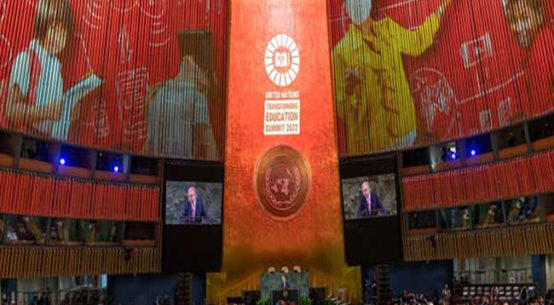
Power generation from sunlight seems a less priority for the policymakers in Bangladesh, despite its huge potential to lessen dirty energy coming from fossil fuels. Clean and green energy saves not only foreign currency but also helps protect the climate from the devastating impacts emanating from nonrenewable fuel sources. Although the cost saving and cheap source for power generation has been a top global and regional agenda to meet their growing power demand, lessen pressure on costly imports of fossil fuels and save the earth from the carbon emission, renewable energy, particularly solar power is still on the back burner for Bangladesh. Solar remains largely in the nature of the country, but barely in the priority list of the government.
Facing the power outage and frequent load shedding for hours, it is time for policymakers to divert their attention from fossil fuels to clean energy. As the soaring prices of petroleum and gas used for generating polluting energy puts a heavy fiscal burden on the economy and consumers alike, it is high time to turn to sunlight for cheap and green power. Households suffer, industries lose their work hours and competitiveness for unreliable power supply, as the typical power generation is highly dependent on the imported volatile energy market.
The nation is oblivious to the necessity of shifting from a dirty energy regime to a clean source of energy management, adopting the cheapest power option, and ensuring energy security in the country in the best possible way. As of today, Bangladesh generates only 459 MW from solar power systems, or only 1.9 per cent of its total power generation, in contrast to 29 per cent in the global perspective, and 13.22 per cent by neighboring India. According to the International Renewable Energy Agency (IRENA), fossil fuels, such as coal, oil and gas, are by far the largest contributor to global climate change, accounting for over 75 per cent of global greenhouse gas emissions and nearly 90 per cent of all carbon dioxide emissions. In contrast, renewable energy, according to the IRENA, is cheaper, and environment-friendly. Renewable energy is the energy collected from renewable resources such as sunlight, wind, water movement, and geothermal heat that are naturally replenished.
According to the Power Development Board, installed capacity for solar power is now 949.64 MW, while generation is only 459 MW or 1.9 per cent of total power generation. The government earlier had targeted to generate 10 per cent of power from solar energy by 2022. It has now revised the plan and targets to generate 40 per cent from sunlight by 2040.
As of now, Bangladesh’s total power generation capacity stands at 26,700 MW – 3.5 per cent or 957.67 megawatts from renewable energy sources.
Power generation was 2,4143 MW on June 18, this year. Of the total, coal-fired power was 3440 MW or 14.25 per cent of the total generation, gas fired 11,372 MW, or 47.10 per cent, furnace oil 6,441 MW, or 26.68 per cent, diesel run 1,041 MW, or 4.3 per cent, hydro 239 MW, or 0.95 per cent, imported 1160 MW, or 4.8 per cent.
India now obtains 151.3 GW, or 13.22 per cent of its total generation from the solar system, Sri Lanka 2.3 per cent and Pakistan gets only 2 per cent of its power from the solar system.
Bangladesh lags behind its regional peer countries. India has plans to obtain 40 per cent of installed power generation capacity from clean energy sources by 2030.
In Bangladesh, there are some 2,592 solar irrigation units producing 48.14MW; some 296,861 street lights with a capacity of 17.07MW; 115 rooftop units (except for net metering) of 14.20MW and 1,933 solar-powered telecom BTS generating 8.06MW, according to the latest data of IDCOL.
In the last couple of years, many local and foreign investors have expressed their interest in setting up large-scale solar plants. During this time, eight solar parks have been established and these are now adding around 180-230MW to the national grid every day.
Despite repeated calls by green groups at home and abroad to shift to clean energy, Bangladesh’s initiatives to shift to renewable energy are sluggish. According to the Sustainable And Renewable Energy Development Authority
(Sreda), the government had undertaken around 50 grid-connected large solar power projects in the past 10 years. But the success rate is only around 15 per cent.
Since Bangladesh has had to import fossil fuels to produce nearly two-thirds of the electricity and their prices are on the rise in the global market for the last couple of years, increasing numbers of private firms are coming forward with mega projects in the renewable energy sector.
According to experts, green energy projects are cheaper and cleaner than the power plants run by fossil fuels. They do not need fuel to generate electricity and do not emit any harmful gas.
A rapid scale-up of 2,000MW solar power capacity and replacement of all diesel-run irrigation systems by solar power could save over $1 billion per year for Bangladesh, which currently goes to LNG and diesel imports, finds a study conducted by the US-based institute, National Bureau of Asian Research, in March, this year.
The study report also said that industries can reduce per unit electricity cost during the daytime by 40 per cent compared to the cost of grid electricity while utility-scale solar is 14 per cent less than the average electricity generation cost of the Bangladesh Power Development Board.
The study additionally revealed that Bangladesh could build more than 12,000 MW renewable energy capacity using industrial rooftops and special economic zones land, without putting any pressure on the agricultural land.
A global energy think tank Ember in its August 2022 report says Bangladesh could generate 6,500 megawatts of solar electricity in the next three years if the country invests $11 billion in solar instead of importing LNG from the spot market at the same cost.
At the same time, the investment in green energy could save the country $2.7 billion and reduce its dependence on LNG (liquified natural gas) by 25 per cent, the London-based group said in its analysis on Bangladesh’s energy security.
Highlighting the case of India, Ember said India was building solar power plants spending $560 million for each gigawatt. Assuming 50 per cent more project cost in Bangladesh, around 6.5 gigawatts could still be installed with $11 billion, which Ember data show electricity demand in the country saw a rise on an average of 8 per cent annually.
“The Mujib Climate Prosperity Plan published in 2021 laid out ambitious solar targets. Had this plan been fully implemented, additional solar generation could have reduced these imports by 25 per cent between 2022 and 2024, saving about $2.7 billion,” Ember’s report added.
Bangladesh’s Energy and Mineral Resources Division data show that by the financial year 2021-2022, LNG imports accounted for 22 per cent of the country’s total gas requirement.
On the other hand, IEEFA’s (Institute for Energy Economics and Financial Analysis) recent analysis shows about 59 per cent of its LNG imports come from the spot market, exposing the sector to volatile prices.
In 2021-22, the government spent Tk 7,614 crore to buy the 10 per cent LNG from the spot market, whereas the 75 per cent local gas production cost only Tk 5,196 crore, according to Petrobangla data.
The average cost of setting up a solar plant is usually Tk8 crore per megawatt, officials said.
“Bangladesh can generate 20,000MW of green electricity within 2041 by expanding solar power generation facilities,” says the “National Solar Energy Roadmap 2021-41” prepared by the Sustainable and Renewable Energy Development Authority. Even solar power capacity can be taken to 30,000MW with proper utilisation of riverside and abandoned lands, it is estimated.
The production cost for a unit of electricity is Tk22 on average at diesel-run power plants, Tk10 at LNG-run plants, Tk4-6 at coal-fired plants and Tk12 at furnace oil-run plants, according to the Bangladesh Power Development Board, while the cost is Tk0.3-1 at Kaptai hydropower plant.
Solar power production costs remain near Tk10 per unit.
“The good news is that the lifeline is right in front of us,” said the UN Secretary-General António Guterres recently, stressing that renewable energy technologies like wind and solar already exist today, and in most cases, are cheaper than coal and other fossil fuels. We now need to put them to work, urgently, at scale and speed.
The issue of renewable energy has come into focus these days for two reasons: Firstly, around 100 nations pledged at the COP26 (Conference of Parties) at Glasgow in 2021 to slash methane emissions. Secondly, fuel oil prices have spiked following the Russia-Ukraine war which has its rippling effect on economies across the globe.
Fossil-fuel subsidies are one of the biggest financial barriers hampering the world’s shift to renewable energy. The International Monetary Fund (IMF) says that about $5.9 trillion was spent on subsidizing the fossil fuel industry in 2020 alone, including through explicit subsidies, tax breaks, and health and environmental damages that were not priced into the cost of fossil fuels. That’s roughly $11 billion a day.
Fossil fuel subsidies are both inefficient and inequitable. Across developing countries, about half of the public resources spent to support fossil fuel consumption benefit the richest 20 per cent of the population, according to the IMF.
Shifting subsidies from fossil fuels to renewable energy not only cuts emissions, it also contributes to sustainable economic growth, job creation, better public health and more equality, particularly for the poor and most vulnerable communities around the world, maintains the IMF in its recent report.
In the Secretary-General’s words, “Renewables are the only path to real energy security, stable power prices and sustainable employment opportunities.”
The International Renewable Energy Agency (IRENA) estimates that 90 per cent of the world’s electricity can and should come from renewable energy by 2050.
Renewable energy is the cheapest power option in most parts of the world today. Prices for renewable energy technologies are dropping rapidly. The cost of electricity from solar power fell by 85 per cent between 2010 and 2020. Costs of onshore and offshore wind energy fell by 56 per cent and 48 per cent respectively.
Under the given situation, policymakers of Bangladesh should focus on generating solar power using rooftops of households, and industries, and adopt floating solar technology to lessen dependence on imported and traditional fossil fuels. Private sectors should be drawn to invest in solar with attractive fiscal benefits.
It is not all about saving foreign currency, but upholding measures to tackle climate emergencies with a definite path to sunlight regime.
Nazmul Ahsan is a former president of Economic Reporters’ Forum. He can be reached by email at Nazmulahsan6504@gmail.com


